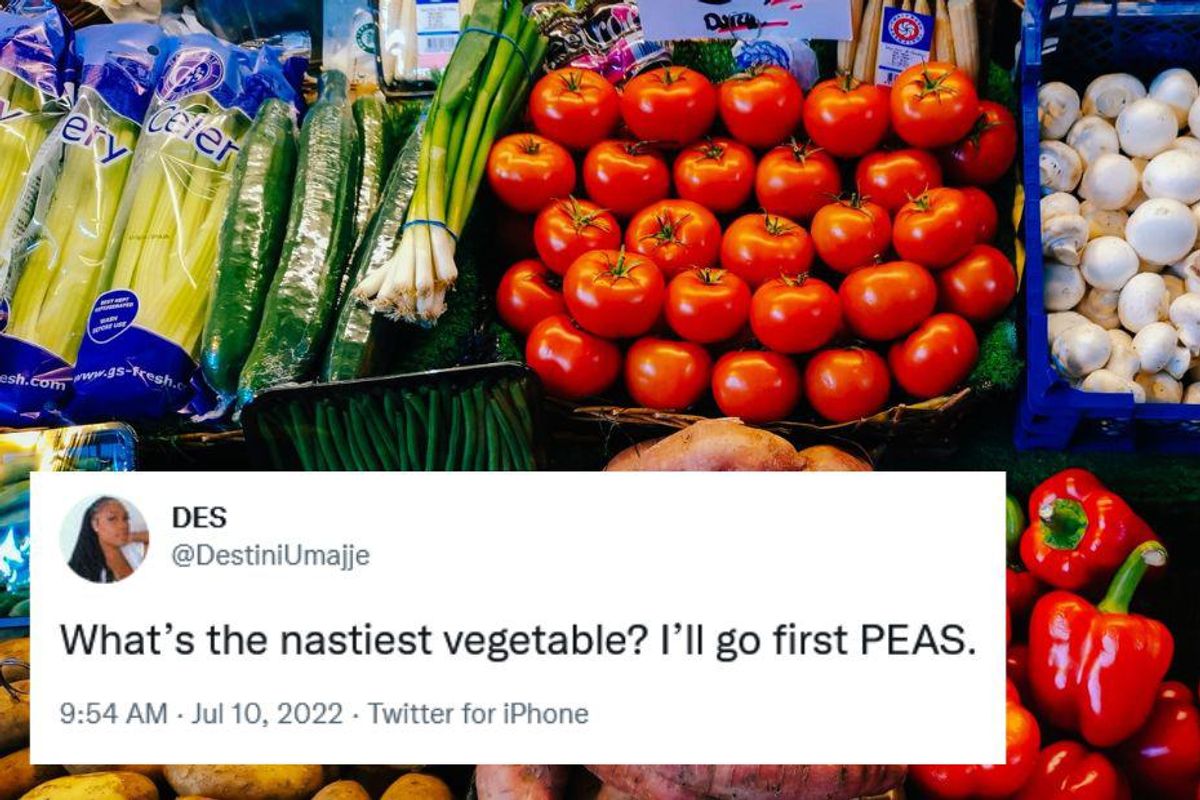Woman declared peas the 'nastiest' vegetable, and people chimed in with their veggie beefs
Brussels sprouts are really just misunderstood.

A Twitter thread declared peas to be the "nastiest vegetable."
Everyone has that one vegetable that turns them into a sneering 3-year-old. You know what I mean. The one you straight-up refuse to eat and if it was the only food available to you, you'd rather starve then let it touch your lips. Some people just can't get behind spinach and apparently a lot of people dislike turnips, others will say Brussels sprouts are the absolute worst. One woman on Twitter declared that peas are the "nastiest" vegetable, and while some people agreed with her, others chimed in to give their opinions.
For some of us, our distaste for certain veggies is something concrete, like a traumatic memory. Maybe when you were a kid, you had them prepared a particular way and it soured you on the veggie for the rest of your life. Or it could be an aesthetic choice—some vegetables taste delicious but don't look it. You do eat with your eyes first, after all. For others, there's the issue of taste. Some people simply can't eat a vegetable because it tastes terrible to them.
In 2019, scientists revealed that there are people called "super-tasters" who have a genetic predisposition to taste food differently than others. For super-tasters, leafy dark green veggies like broccoli, Brussels and cabbage taste extremely bitter and unappetizing. According to a CNN article on the subject, people with this "bitter" gene are 2.6 times more likely to not eat as many vegetables in general because of the bitter taste of others.
“So that [bitter] vegetable is disliked, and because people generalize, soon all vegetables are disliked,” Valerie Duffy, a University of Connecticut professor and expert in the study of food and taste, told CNN. “If you ask people, ‘Do you like vegetables?’ They don’t usually say, ‘Oh yeah, I don’t like this, but I like these others.’ People tend to either like vegetables or not.”
When user DES made her declaration, the responses were swift.
Canned GREEN Lima beans 🤮🤮🤮
— tbd... (@YoungUmmi) July 10, 2022
Asparagus. Never had it but it’s just so ugly 🤮 pic.twitter.com/r0QDxBNigC
— 𝐉𝐔𝐍𝐈𝐎𝐑 (@WrittenByTerry) July 11, 2022
Let me see a mushroom ANYWHERE near something that I plan to eat & you'll see me get violently repulsed & upset
— Harriet Tubman's Armorbearer 😏🤯🤭🤷🏽♀️ (@LocdbyanAngel24) July 11, 2022
Lima beans literally didnt have to make through evolution
— FullGhetto Alchemist (@FlintGreyJune) July 11, 2022
Water infused grasssss🤢🤮
— Butterfly in the sky🦋 (@ayenyeree) July 11, 2022
Okra is Mother Nature's boogas.
— The Foncé Is Fully Vaxxed n' Boosted😷 💉 (@ChocnessMonsta) July 11, 2022
Periodt.
But for all the veggie haters out there, there are people who'll come to their defense as well.
Used to think that but roasted till they're crispy with some balsamic vinegar and YUM!
— Jen (@jenniredd37) July 11, 2022
Butter, sugar and black pepper for me please
— 𝕷𝖎𝖔𝖗 𝕮𝖎𝖋𝖊𝖗𝖎 (@thatwhorelior) July 11, 2022
What the hell they talking bout peas is the best and with the carrots in them too
— $$C.Rizzle$$ (@KingCRayCr88) July 11, 2022
Don’t be disrespectful
— Shadiah✨ (@Play_YoRoll) July 11, 2022
Don’t you ever say in your life again that brussel sprouts are nasty. Blasphemous
— Shawn Crysis (@ShawnCrysis) July 11, 2022
I just be snacking on raw carrots like a rabbit. If theyre sweet especially, they are the best
— . (@BakedPoetato) July 11, 2022
- Guess how much produce is thrown out because it's not pretty ... ›
- Australia is airdropping fresh veggies to feed animals in fire-ravaged ... ›
- How a giant cabbage eventually helped this girl feed hundreds of ... ›
- Musicians use veggies as instruments, cook leftovers to feed ... ›
- This tiny piece of paper can keep fruits and vegetables fresh 2 to 4 ... ›

